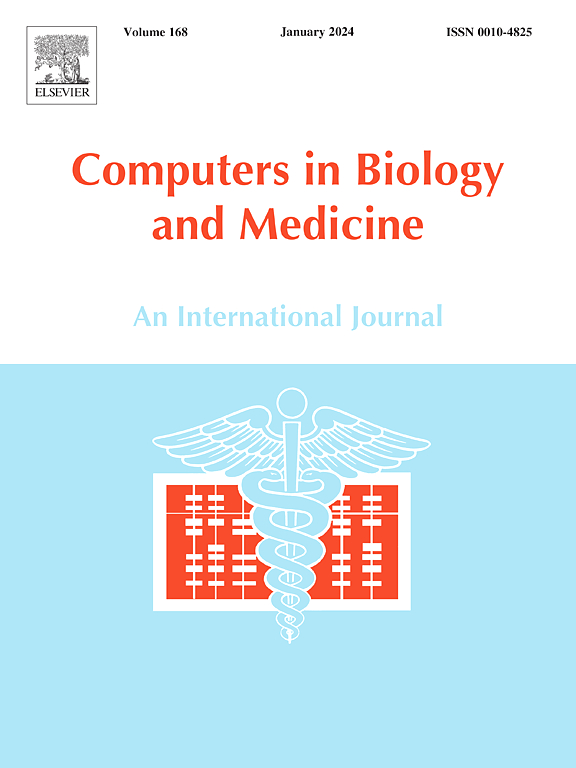Exploring best-performing radiomic features with combined multilevel discrete wavelet decompositions for multiclass COVID-19 classification using chest X-ray images
IF 7
2区 医学
Q1 BIOLOGY
引用次数: 0
Abstract
Discrete wavelet transforms have been applied in many machine learning models for the analysis of COVID-19; however, little is known about the impact of combined multilevel wavelet decompositions for the disease identification. This study proposes a computer-aided diagnosis system for addressing the combined multilevel effects of multiscale radiomic features on multiclass COVID-19 classification using chest X-ray images. A two-level discrete wavelet transform was applied to an optimal region of interest to obtain multiscale decompositions. Both approximation and detail coefficients were extensively investigated in varying frequency bands through 1240 experimental models. High dimensionality in the feature space was managed using a proposed filter- and wrapper-based feature selection approach. A comprehensive comparison was conducted between the bands and features to explore best-performing ensemble algorithm models. The results indicated that incorporating multilevel decompositions could lead to improved model performance. An inclusive region of interest, encompassing both lungs and the mediastinal regions, was identified to enhance feature representation. The light gradient-boosting machine, applied on combined bands with the features of basic, gray-level, Gabor, histogram of oriented gradients and local binary patterns, achieved the highest weighted precision, sensitivity, specificity, and accuracy of 97.50 %, 97.50 %, 98.75 %, and 97.50 %, respectively. The COVID-19-versus-the-rest receiver operating characteristic area under the curve was 0.9979. These results underscore the potential of combining decomposition levels with the original signals and employing an inclusive region of interest for effective COVID-19 detection, while the feature selection and training processes remain efficient within a practical computational time.
结合多层离散小波分解,探索胸部x线图像多类别COVID-19分类的最佳放射学特征
离散小波变换已应用于许多机器学习模型中,用于分析COVID-19;然而,关于多层小波组合分解对疾病识别的影响知之甚少。本研究提出了一种计算机辅助诊断系统,用于解决胸部x线图像多尺度放射学特征对COVID-19多类别分类的多重综合影响。将两级离散小波变换应用于最优感兴趣区域以获得多尺度分解。通过1240个实验模型对不同频带的近似系数和细节系数进行了广泛的研究。采用基于过滤器和包装器的特征选择方法对高维特征空间进行了管理。在波段和特征之间进行了全面的比较,以探索性能最好的集成算法模型。结果表明,引入多层次分解可以提高模型的性能。一个包括肺和纵隔区域的包容性区域被确定,以增强特征表征。光梯度增强机应用于具有基本、灰度、Gabor、定向梯度直方图和局部二值模式特征的组合波段,加权精度、灵敏度、特异性和准确度分别达到97.50%、97.50%、98.75%和97.50%。covid -19与其他受试者的曲线下工作特征面积为0.9979。这些结果强调了将分解水平与原始信号相结合并采用包容性感兴趣区域进行有效COVID-19检测的潜力,同时在实际计算时间内保持特征选择和训练过程的效率。
本文章由计算机程序翻译,如有差异,请以英文原文为准。
求助全文
约1分钟内获得全文
求助全文
来源期刊

Computers in biology and medicine
工程技术-工程:生物医学
CiteScore
11.70
自引率
10.40%
发文量
1086
审稿时长
74 days
期刊介绍:
Computers in Biology and Medicine is an international forum for sharing groundbreaking advancements in the use of computers in bioscience and medicine. This journal serves as a medium for communicating essential research, instruction, ideas, and information regarding the rapidly evolving field of computer applications in these domains. By encouraging the exchange of knowledge, we aim to facilitate progress and innovation in the utilization of computers in biology and medicine.
 求助内容:
求助内容: 应助结果提醒方式:
应助结果提醒方式:


